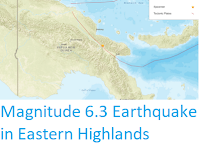Fifteen people, including three children, are feared to have died after a landslide hit a mining camp in the Saki area of Goilala District in Central Province, Papua New Guinea, on Monday 28 December 2020. The landslide hit a long house which is reported to have been occupied by local artisanal miners who were digging and panning for gold in the area; there are not thought to have been any survivors, although the remote location of the site meant that rescue workers did not reach the site until the next day, and only two bodies have been found to date, so it is possible that there were survivors.
The incident is reported to have happened following days of heavy rain associated with the onset of the local Monsoon Season, which typically lasts from December till March. Landslides are a common problem after severe weather events, as excess pore water pressure can overcome cohesion in soil and sediments, allowing them to flow like liquids. Approximately 90% of all landslides are caused by heavy rainfall. It is also possible that the activities of the miners destabilised the hillslope where the slippage occurred.
Monsoons are tropical sea breezes triggered by heating of the land during the warmer part of the year (summer). Both the land and sea are warmed by the Sun, but the land has a lower ability to absorb heat, radiating it back so that the air above landmasses becomes significantly warmer than that over the sea, causing the air above the land to rise and drawing in water from over the sea; since this has also been warmed it carries a high evaporated water content, and brings with it heavy rainfall. In the tropical dry season the situation is reversed, as the air over the land cools more rapidly with the seasons, leading to warmer air over the sea, and thus breezes moving from the shore to the sea (where air is rising more rapidly) and a drying of the climate.
Papua New Guinea, and other countries of the western Pacific margin, is experiencing a particularly wet year, due to a prevailing La Niña weather system over the Pacific. The La Niña weather system is the opposite of the El Niño weather system, in which unusually cold surface temperatures spread across the equatorial Pacific from the upwelling zone on the South American coast. This traps warm water from the western Pacific, preventing it from spreading east and warming the central Pacific. This leads to lower evaporation over the (cooler) east Pacific, leading to low rainfall on the west coast of South America, and higher evaporation over the (warmer) west Pacific, leading to higher rainfall over East and Southeast Asia and northern Australia.
See also...



Follow Sciency Thoughts on Facebook.
Follow Sciency Thoughts on Twitter.






